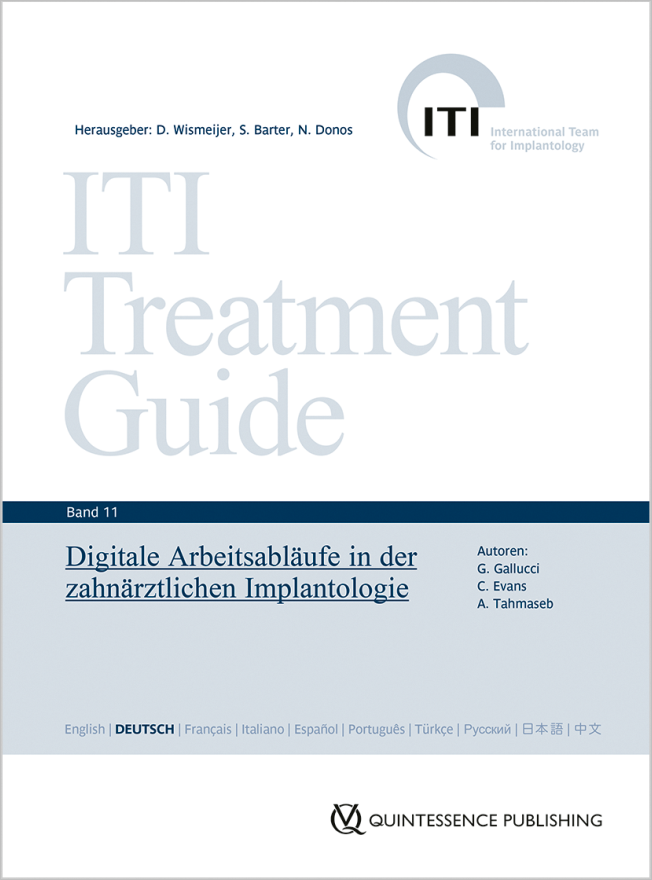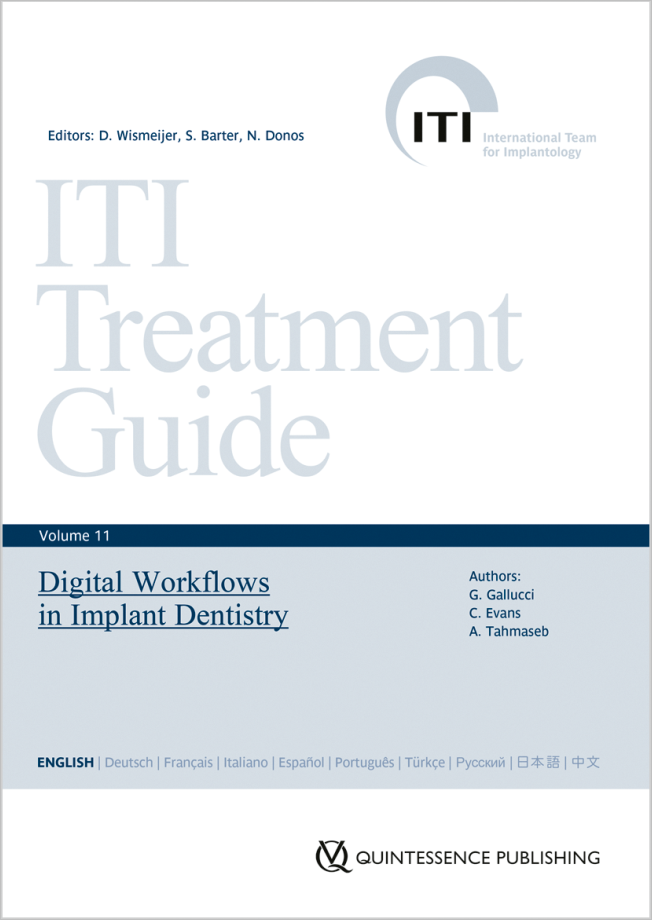QZ - Quintessenz Zahntechnik, 1/2015
AbstractPáginas 55, Idioma: AlemánKapos, Theodoros / Evans, ChristopherThe International Journal of Oral & Maxillofacial Implants, 7/2014
SuplementoDOI: 10.11607/jomi.2014suppl.g2.3, ID de PubMed (PMID): 24660194Páginas 117-136, Idioma: InglésKapos, Theodoros / Evans, ChristopherPurpose: The aim of this systematic review was to compare implant prostheses fabricated by computerassisted design and computer-assisted manufacturing (CAD/CAM) with conventionally fabricated implant prostheses when assessing esthetics, complications (biologic and mechanical), patient satisfaction, and economic factors.
Materials and Methods: Electronic searches for clinical studies focusing on long-term follow-up were performed using the PubMed and Ovid search engines. Concentrating on the restorative aspect of the CAD/CAM technology applicable to implant dentistry, pertinent literature was divided into articles related to implant abutments, crowns, and frameworks.
Results: A total of 18 articles satisfied the inclusion criteria. Two articles reported on CAD/CAM crowns, six on abutments, and 10 on implantsupported CAD/CAM frameworks. The mean survival rate for CAD/CAM crowns was 98.85% and for CAD/ CAM abutments 100%. The mean survival rate for CAD/CAM frameworks was 95.98%.
Conclusion: Based on the current literature, CAD/CAM fabricated crowns, abutments, and frameworks demonstrate survival rates comparable to conventionally fabricated prostheses. Implant survival appears unaffected by fabrication technique. Since this technology encompasses several manufacturing variations, a new definition might be necessary to accurately define the processes under which the CAD/CAM restorations are fabricated. "Complete CAD/CAM product" where no or minimal manual intervention is employed could be a possible term.
Palabras clave: abutment, CAD/CAM, crown, dental prosthesis implant-supported, implant-supported framework, implant superstructure
The International Journal of Oral & Maxillofacial Implants, 7/2014
SuplementoDOI: 10.11607/jomi.2013.g2, ID de PubMed (PMID): 24660195Páginas 137-140, Idioma: InglésWismeijer, Daniel / Brägger, Urs / Evans, Christopher / Kapos, Theodoros / Kelly, J. Robert / Millen, Christopher / Wittneben, Julia-Gabriela / Zembic, Anja / Taylor, Thomas D.QZ - Quintessenz Zahntechnik, 11/2014
SciencePáginas 1398-1405, Idioma: AlemánWismeijer, Daniel / Brägger, Urs / Evans, Christopher / Kapos, Theodoros / Kelly, Robert / Millen, Christopher / Wittneben, Julia-Gabriela / Zembic, Anja / Taylor, Thomas D.International Team for Implantology 2013Der Beitrag veröffentlicht eine Konsensuserklärung der Gruppe 2 des "International Team for Implantology" (ITI) zum Thema "Klinische Empfehlungen zu restaurativen Materialien und Techniken bei Implantatversorgungen". Die Arbeitsgruppe hat in der Fachliteratur Angaben zu Überlebensraten und zur Häufigkeit von biologischen, technischen und ästhetischen Problemen, die auf mittleren Beobachtungszeiträumen von mindestens 5 Jahren basieren, dokumentiert und zusammengestellt. Auf Basis dieser Daten wurden Richtlinien und Empfehlungen formuliert.
Palabras clave: Implantatprothetik, Implantatzahntechnik, Überlebensraten, klinische Bewährung
QZ - Quintessenz Zahntechnik, 10/2014
SciencePáginas 1296-1310, Idioma: AlemánHamilton, Adam / Judge, Roy B. / Palamara, Joseph E. / Evans, ChristopherDiese Studie sollte die Passform von CAD/CAM-gefertigten Implantatabutments eines bestimmten Anbieters mit herstellergebundenen konfektionierten Abutments auf verschiedenen Implantatsystemen vergleichen. Auf fünf verschiedenen Implantattypen wurden CAD/CAM-gefertigte Titanabutments mit konfektionierten Abutments verglichen. Die Prüfkörper wurden in Epoxidharz eingebettet, ein Längsschnitt wurde hergestellt und poliert. Die Abstände (Spaltbreiten) zwischen Implantaten und Abutments wurde an den horizontalen (Flanschen) und den internen vertikalen Komponenten rasterelektronenmikroskopisch vermessen. Beim Vergleich der Messwerte wurde der t-Test für unabhängige Stichproben eingesetzt.
Palabras clave: Implantatprothetik, CAD/CAM-gefertigte Implantatabutments, konfektionierte Implantatabutments, Passform, Spaltbreiten
The International Journal of Prosthodontics, 4/2013
DOI: 10.11607/ijp.3501, ID de PubMed (PMID): 23837169Páginas 370-380, Idioma: InglésHamilton, Adam / Judge, Roy B. / Palamara, Joseph E. / Evans, ChristopherPurpose: This study aimed to compare the fit of computer-aided design/computerassisted manufacture (CAD/CAM) abutments provided by a single system with proprietary prefabricated abutments on various implant systems.
Materials and Methods: Titanium CAD/CAM abutments were compared with prefabricated abutments on five different implant types. The samples were embedded in epoxy resin, sectioned longitudinally, and polished. Scanning electron microscopy was used to measure the gap between the implants and abutments at the connecting flanges and internal features. Independent t tests were used to compare data.
Results: A mean difference of 1.86 µm between the gold synOcta and CAD/CAM abutments on the Straumann Standard Plus implant was observed to be statistically significant (P = .002). Less than 0.4 µm of difference was found between the CAD/CAM and prefabricated abutments for the remaining implant types, and statistical significance was not observed. Mean differences of 34.4 µm (gold) and 44.7 µm (titanium) were observed between the CAD/ CAM and prefabricated abutments on the Straumann Standard Plus implants, which were statistically significant (P .001). A mean difference of 15 µm was also observed between the CAD/CAM and prefabricated abutment on the NobelReplace implant, which was statistically significant (P = .026). All other groups had less that 4 µm of difference, and statistical significance was not observed.
Conclusion: The CAD/CAM abutments appeared to have a comparable fit with prefabricated abutments for most of the systems evaluated. Design differences between the abutment connections for both Straumann implants were observed that affected the fit of internal components of the implant-abutment connections.
The International Journal of Prosthodontics, 5/1999
Páginas 439-443, Idioma: InglésEvans, Christopher D. J. / Wilson, Peter R.Purpose: The purpose of this study was to determine pressure changes in the pulp space during tooth preparation with either diamond or tungsten carbide burs in a high-speed dental handpiece in the laboratory. Materials and Methods: Twenty premolar teeth were collected and randomly assigned to two groups: group 1 received preparation with diamond burs and group 2 with tungsten carbide burs. The teeth were mounted on a pressure transducer and the pulp chambers were filled with saline. A 0.1-mm thickness of tooth tissue was removed from the proximal surface of each tooth, alternating dry and wet cutting, until the pulp chamber was exposed. Pressure and temperature changes were recorded during tooth preparation. Results: At 0 to 1 mm of remaining dentin depth dry cutting with diamond and tungsten carbide burs generated a mean positive pulpal pressure of 12 kPa and 6 kPa, respectively. Wet cutting under the same conditions produced 0.6 kPa and 0.15 kPa, respectively. The difference between wet and dry cutting was highly significant (P 0.001). Diamond burs produced significantly higher pressure increases than carbide burs at all levels for both wet and dry techniques (P 0.05). When cutting farther than 2 mm from the pulp, tooth preparation created a mean 0.09-kPa pressure increase, which was not influenced by either coolant use or bur type. The temperature change was minimal during wet cutting and only minor temperature increases were recorded during dry cutting. Conclusion: From this laboratory study it is concluded that significant pressure changes occur in the pulp chamber during tooth preparation of extracted teeth when the remaining dentin thickness is less than 2 mm.






